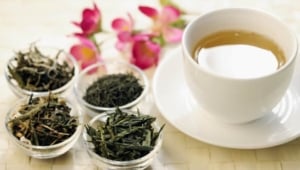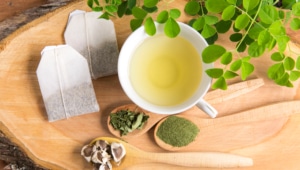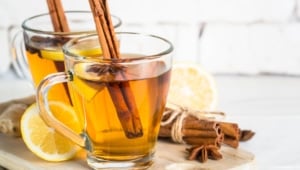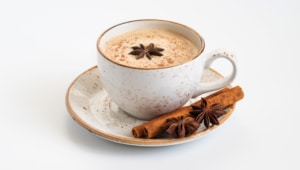12 Best Green Teas & 4 Tasty Alternatives
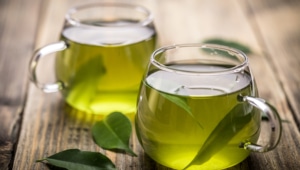
People consume around 6.7 billion kilograms of tea worldwide. It’s the most commonly enjoyed beverage after water. But why is green tea so popular, and what defines the best kinds? In this article we explore what green tea is, nutrition facts, and what types you should definitely try.
Green tea is the oldest known form of tea and traces back to 2737 BC China. It’s said that tea was discovered when Chinese Emperor Shennong had water which had accidentally been boiled with a tea leaf in it. He liked the taste of it, and inspired the world to come to enjoy tea forever.
What Green Tea Is

What Green Tea Is
Green tea is one of the healthiest drinks you can enjoy. It’s loaded with antioxidants called catechins, vitamins, and minerals.
The presence of antioxidants in green tea make it particularly helpful for cell renewal, fighting free radicals in the body, and protecting against diseases. Amino acids in the tea leaves also help ward off stress, fight insomnia, and help you relax.
Typical Ingredients

Typical Ingredients
Green tea is made with dried leaves from the camellia sinensis plant.
Different parts of the same plant are also used to craft oolong and black teas. In the case of green tea, the leaves are steamed, then pan-fried, and then dried.
The dried leaves are then steeped to create the green tea you know and love.
Origin of Green Tea

Origin of Green Tea
The origins of green tea go back to the Yunnan province in China, where camellia sinensis plants were first grown.
There, a stray leaf first found its way into Emperor Shennong’s cup of boiled water. When he deemed it delicious, tea became an intentionally prepared beverage.
In Japan, green tea in the form of matcha is used in traditional tea ceremonies. These are conducted with an aim to bring harmony to guests, as well as recognising beauty in an otherwise flawed world.
As you can see, tea is so much more than just a beverage. Green tea in particular offers many health benefits and, when prepared correctly, can add a small oasis of relaxation to your day.
Caffeine in Green Tea

Caffeine in Green Tea
An 8 fluid ounce cup of tea contains on average 29 milligrams of caffeine, with an equivalent cup of coffee containing 96 milligrams of caffeine. A cup of matcha green tea is said to contain around 70 milligrams of caffeine, since it’s much more concentrated.
Best Time to Drink Green Tea

Best Time to Drink Green Tea
Green tea is best enjoyed between the morning and early afternoon hours of the day. Its caffeine content would make it less beneficial in the later afternoon or evening, as it could then disrupt your sleep.
It’s said to be ideally enjoyed after meals, as the high catechin contents of the tea might harm your liver otherwise. Green tea is also a good addition to your routine pre-workout sessions.
This is because it may help you break down fat, as well as reducing inflammation and swelling. Green tea may even help diminish the chance of injury and aid in recovery due to its anti-inflammatory properties.
Best Green Tea You Should Try

Best Green Tea You Should Try
There are many different green teas available to buy. From traditional one-ingredient green teas to special mixes, you’ll want to try a variety until you find your go-to one. Below are our favorite green teas to start with.
VAHDAM Teas Organic Himalayan Green Tea

VAHDAM Teas Organic Himalayan Green Tea
This 100 percent pure green tea is made and packed at the source in India. It’s a loose leaf tea that’s vacuum sealed to keep in all the goodness. Best of all, this tea is certified USDA Organic, non-GMO, high grown, and gluten free.
The Republic of Tea People’s Green Tea

The Republic of Tea People’s Green Tea
This green tea is made of premium Chinese tea leaves packed in round, unbleached tea bags. The Republic of Tea’s teas are grown without the use of pesticides or synthetic chemicals.
They claim to procure organic herbs and teas, though not all of the organic farmers they source from are officially certified.
Twinings Green Tea
Twinings Green Tea is a budget-friendly supermarket option. You get single use tea bags containing natural, high-quality green tea leaves. Twinings teas aren’t necessarily all pesticide-free, though many are USDA Organic and Fair Trade Certified.
Best Green Tea for Weight Loss

Best Green Tea for Weight Loss
Green tea contains catechins and caffeine, both of which help boost your metabolism and digestive system. Yet not all green teas are necessarily made the same. Some are blended with additional herbs to help you lose weight. Here are our favorites.
Tetley Green Tea

Tetley Green Tea
This drink is 100 percent Rainforest Alliance Certified and one of the founding members of the Ethical Tea Partnership.
Tetley green tea is made from young tea leaves and tea buds, offering a smooth, diet-friendly green tea. Like Twinings, not all Tetley teas are necessarily pesticide-free, as they are mass-produced.
Yogi Green Tea

Yogi Green Tea
Yogi Tea sell two great green teas for dieting: Green Energy with green tea, guarana, ginger, and elderflower. And Green Balance with green tea, lemon grass, and peppermint.
Green Energy may be good for boosting your energy levels to exercise, while Green Balance’s ingredients could make you feel less hungry and fight inflammation.
Yogi Teas are also organic, meaning they’re free from harmful chemicals.
Organic India Tulsi Green Tea

Organic India Tulsi Green Tea
This blend of organic green tea and tulsi holy basil makes a great addition to your weight loss diet. It’s certified organic and made in India.
The blend contains three kinds of tulsi as well as high-quality green tea leaves, packed in individual use tea bags. Tulsi is said to aid weight loss as it’s high in vitamins and minerals. It also contains virtually no calories.
Best Matcha Green Tea

Best Matcha Green Tea
Matcha tea is a wonderful addition to your diet. It’s delicious, flavorful, and full of health benefits. The issue with matcha is that it comes in a variety of ‘grades’ from culinary to ceremonial standards.
So it can be a little tricky to pick the right kind of matcha green tea. Below are some of the best you can buy.
GOLDE Pure Matcha
Rated as the best matcha tea powder by several magazines, GOLDE matcha is made with 100 percent ceremonial grade green tea powder.
It’s sourced from Uji in Japan, where this tea is grown completely organically, without GMOs, radiation, or heavy metals. It’s certainly not the cheapest matcha, but it is one of the very best.
Ippodo Tea Co. Hatsu

Ippodo Tea Co. Hatsu
Hatsu tea is a lighter matcha which aims to result in a smooth usucha or thin matcha tea. It’s great for blending into lattes and using in baking.
This blend is a budget-friendly option, as it’s much cheaper than other matcha powders. Ippodo Tea is all made in Japan, and there are several organic tea options available.
Naoki Matcha Superior Blend

Naoki Matcha Superior Blend
Naoki create a fine-looking authentic ceremonial grade matcha tea powder. This one is also grown in Uji, but slightly more budget-friendly than the GOLDE tea.
It’s certified organic by JAS, which is recognized by USDA.
Naoki use first harvest tea leaves, which are ground just before being vacuum-sealed for maximum freshness.
Best Organic Green Tea

Best Organic Green Tea
Buying organic food and drinks is sometimes a controversial topic for discussion.
In the case of tea, it is worth knowing that organically grown and processed leaves are free from chemicals, pesticides, fungicides, and various other toxins.
Organic tea is therefore certainly worth investing in. Here are some of the best varieties you can buy.
Traditional Medicinals Green Tea

Traditional Medicinals Green Tea
Traditional Medicinals green tea is a matcha-like blend made with iri genmaicha, which is a blend of green tea leaf and toasted brown rice grains.
It’s said to be invigorating and taste slightly bitter and savoury, with nutty, toasted notes from the rice. Traditional Medicinals boast all-natural and organic tea blends, so you can rest assured that they contain no harmful chemicals.
Rishi Organic Sencha Green Tea
Rish Tea & Botanicals produce this excellent organic sencha green tea. It’s described as lively and fresh with savory and sweet notes. This green tea is harvested from the volcanic soils in Kyushu in Southern Japan. It’s USDA Organic certified whole leaf tea packaged into easy-to use sachets.
Frontier Co-Op Green Tea

Frontier Co-Op Green Tea
Frontier Co-Op offer a really great selection of green tea varieties, including matcha powders.
One of the most exciting, though arguably also one of the most expensive, varieties is their Organic Nepali Green Pearl Tea.
It’s a whole leaf tea made in Nepal, and offers sweet, clean green tea flavors. Frontier Co-Op put great importance in their member-owners who grow their teas, herbs, and spices.
Simple Hacks and Tips to Boost Your Green Tea

Simple Hacks and Tips to Boost Your Green Tea
If plain green tea just isn’t for you, don’t worry. There are plenty of ways you can make it tastier while still reaping all those amazing health benefits.
If you enjoyed the history of this fantastic tea, you’ll also be glad to know that you can buy traditional utensils. Find out more in this section.
Add Fresh Mint and Honey

Add Fresh Mint and Honey
Fresh mint adds a delightful zing and fresh flavor to your tea. It’s also said to improve your brain power, help with indigestion, and make your breath smell lovely.
Honey is said to also help with digestion and even offer antianxiety and antidepressant effects. Mix these with green tea, and you’ve got a nutritional powerhouse you’ll be glad to enjoy.
Buy the Best Quality Green Tea

Buy the Best Quality Green Tea
Matcha tea comes in different grades, ranging from culinary to ceremonial. Standard green tea doesn’t have the same grading, but you’ll still benefit from buying the highest quality you can find and afford.
It’s worth noting that some studies have shown that black and green teas can retain pesticide residues. Opt for organic varieties which are grown free from pesticides, fungicides, and other chemicals.
Invest in Traditional Japanese Tea Utensils

Invest in Traditional Japanese Tea Utensils
If you enjoy preparing and drinking tea, you may wish to invest in some traditional tea utensils.
A chawan tea bowl, chasen whisk, and chashaku teaspoon are all great things to have, particularly if you’re looking to get into making matcha green tea.
There are also some fantastic books available if you’re interested in finding out more about making tea.
Best Alternatives to Green Tea

Best Alternatives to Green Tea
Green tea is a centuries old, well-loved tea all over the world. But let’s face it, not everyone likes the taste of it.
If you don’t enjoy regular green tea, there are other varieties available which offer the same or similar health benefits. Why not try them all and see which one you like best?
Matcha Tea

Matcha Tea
Matcha is a cousin of regular green tea, in that it’s made from green tea leaves which have been grown in the shade and ground into a fine powder after processing.
It is earthier, sweeter, and more floral tasting than green tea. It’s stronger and contains more caffeine, but also offers more of the great nutrients and health benefits of regular green tea.
Rooibos Tea

Rooibos Tea
Rooibos is a South African plant, which has also been enjoyed for centuries. Steeped, it makes a beautiful reddish golden tea that tastes a bit like vanilla and nuts.
It’s sweet on its own with notes of caramel and contains no caffeine, making it perfect as a bedtime drink.
Rooibos is said to lower your blood pressure, improve cholesterol levels, and reduce your risk of developing heart diseases.
Black Tea

Black Tea
Black tea is made from the same camellia sinensis plants as green tea. The difference is in the processing: where green tea leaves are steamed and fried to prevent oxidation from happening, black tea leaves are allowed to oxidize fully.
This process is what turns the leaves black and causes black tea’s distinctive flavors.
The two teas offer many of the same health benefits, though black tea also has theaflavins caused by the oxidation process. These also offer antioxidant properties.
With that said, black tea has less catechins than green tea, meaning it also loses some of the benefits associated with these powerful antioxidants. Black tea also contains more caffeine.
Herbal Teas

Herbal Teas
You may also wish to try a variety of herbal teas and tisanes. If you’re aiming for specific health benefits, you may wish to cater to these directly using herbal teas.
Do bear in mind that not all herbs interact well with all medicines, and that some herbs are advised against in pregnancy. If in doubt, speak with your doctor first.
Some of the most popular herbal teas include:
- Chamomile tea (to calm and relax)
- Peppermint tea (to support your digestive system and invigorate)
- Ginger tea (to combat nausea and fight illnesses)
- Hibiscus tea (to lower cholesterol and blood pressure)
- Echinacea tea (to boost your immune system and ward off infections.)
You may also wish to experiment with homemade tisanes using organically grown produce from your garden such as lavender, rose petals, and mint.
- Cinnamon Tea. Health Benefits and Tips.
- Oreo Cookie Flavors. Best and Weirdest Flavors.
- Starbucks Refresher. Tips and Best Drinks.
- Jelly Belly Flavors. Best and Grossest.
- Boba Flavors. Best Flavors and Types.
- Pop Tart Flavors. Tasty Alternatives and Best Flavors.
